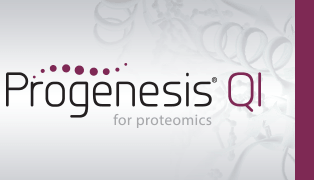How does normalisation behave where peptide ions significantly altered in their abundance are derived from proteins that are not differentially expressed?
Peptides significantly altered in their abundance derived from proteins which do not express any changes in their abundance can be the most interesting from the functional and biological points of view. Here are two examples,
Example 1: A protein exists at the same concentration in both case and control samples but it is being modified at different stoichiometry in both samples. This results in detection of two peptide isoforms (modified and non-modified) and depending on stoichiometry of this modification, both peptide isoforms will look like outliers with or without normalization.
Progenesis QI for proteomics analysis solution to example 1. The different stoichiometry should result in outliers which will have minimal or no influence on the determination of the normalisation factor. In terms of quantitation, we can show that a difference exists at the MS1 level although we have no identification. If we have MS2 data and can get an identification then these different isoforms will be associated with the same protein and our software can currently show this information on a number of levels, e.g. the (un)modified sequence, the relative abundance, the position and also the comparative abundance plots (in the protein view section). This combined information can be very informative and lead the user to biological knowledge that may otherwise have been difficult to piece together.
Example 2: A protein exists at the same concentration in both case and control samples but it is being either modified or not. Cases of presence/absence like this challenge peak matching, alignment and normalization to detect the modified peptide in one sample when it is missing in another.
Progenesis QI for proteomics analysis solution to example 2. Not all proteins are used for alignment and normalization and so a modified protein will not necessarily effect the alignment and normalisation. The missing peak data is not an issue as we create an aggregate data set that contains data from all proteins. Granted, the modified and unmodified forms will result in a present/absence situation and we don't peak match the different forms. As these proteins (or their peptide ions) are not the same (one being modified), there is no reason to match them at this stage of the analysis workflow. However, the t-test or ANOVA test will show all differentially expressed peptide ions such as these modified and unmodified ones. You can investigate these further using an inclusion list or if you have MS2 data you can hopefully identify that they are in fact just modified version of each other and use the existing tools and data views to build up more knowledge about them.
The normalisation implemented within Progenesis QI for proteomics allows us to efficiently pick up differential modifications given in these examples.This illustrates the advantage of being able to combine independent MS1 and MS2 information to generate a clearer picture of what is happening in your experiment. This has been a motivating factor for us in deciding on the work flow we have implemented.





